Elderflower Cordial
By Mike on Sunday, June 30, 2013, 21:19 - Permalink
 30 June 2013 - This cordial captures the fragrant grape-like flavour of Elderflowers, but is much quicker and easier to make than Elderflower Fizz.
30 June 2013 - This cordial captures the fragrant grape-like flavour of Elderflowers, but is much quicker and easier to make than Elderflower Fizz.
It can be diluted with still or sparking water to make a delicious summery drink, or can be used as a light syrup for fruit salads or cocktails.
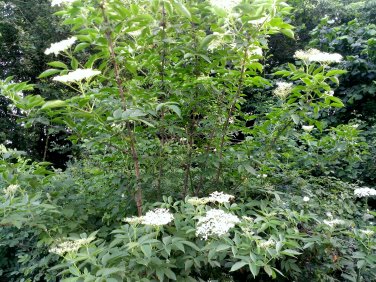 The Elder tree (Sambucus nigra) is a fast-growing tree with upright, pithy branches. In early summer, it produces large, flat umbels of creamy white, fragrant flowers.
The Elder tree (Sambucus nigra) is a fast-growing tree with upright, pithy branches. In early summer, it produces large, flat umbels of creamy white, fragrant flowers.
(Harry Potter fans may note that this is the tree from which the Elder Wand is made)
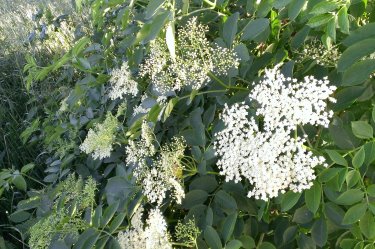 But it's the flowers with which we will be making magic here.
But it's the flowers with which we will be making magic here.
Select the flower heads that are fully open and creamy yellow-white in colour - these are the best ones of flavour - if they've turned pale white, or brown, or if they have dark centres instead of yellow, they will be no good for making cordial.
Pick whole umbels of flowers - the quantity you pick is up to you - I gathered about half a plastic grocery shopping bag full, which was enough to make two bottles of cordial.
It's worth inspecting the flowers for large insects before they go in the bag - green caterpillars are quite common - transfer them to another part of the plant so that they can continue their lifecycle (or so they can provide food for other wildlife).
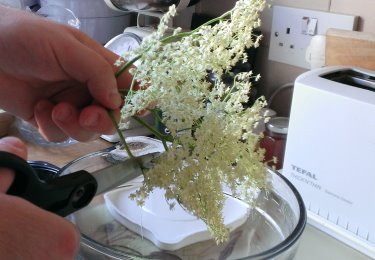 Inspect the flower heads again for small insects such as flea beetles and shake these off.
Inspect the flower heads again for small insects such as flea beetles and shake these off.
Using sharp scissors, cut the flowers away from the thicker branches of stem - discarding as much stem as possible, but keeping the flowers - it's OK to keep the finer branched stems though.
Allow the flowers to fall into a large bowl or pan.
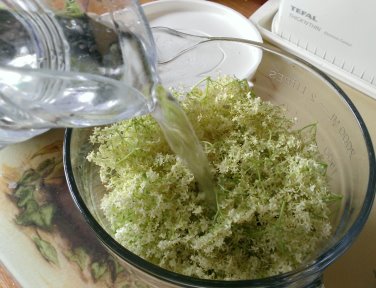 Pour over enough cold water to completely immerse the flowers - press them down to ensure they're fully submerged.
Pour over enough cold water to completely immerse the flowers - press them down to ensure they're fully submerged.
Cover and leave to infuse for half an hour - an occasional stir will help to infuse the aroma of the flowers into the liquid.
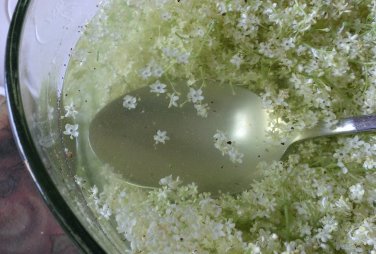 After the flowers have infused, the water will turn pale greenish yellow in colour and slightly cloudy.
After the flowers have infused, the water will turn pale greenish yellow in colour and slightly cloudy.
Don't worry about all the bits floating about - or if there are any remaining small insects swimming/drowning - because the next stage is to strain the liquid.
Strain off the liquid through a fine sieve, jelly cloth, muslin or (as here) coffee filter paper.
Discard the flowers (they can be composted).
 Measure the quantity of liquid
Measure the quantity of liquid
For each litre of liquid (approx 1.75 UK pints, or 1 US quart), you will need:
- The strained juice of one lemon
- 200g (approx 7 ounces or 1 cup) of granulated white sugar
 Transfer the liquid to a large pan, add the sugar and lemon juice, then warm over a moderate heat until the sugar is dissolved.
Transfer the liquid to a large pan, add the sugar and lemon juice, then warm over a moderate heat until the sugar is dissolved.
Then turn up the heat and bring to the boil - allow to boil for no more than a minute (or you will boil out the aromatic flavours) then take off the heat.
 There are two options for bottling, depending on whether you intend to keep the cordial refrigerated.
There are two options for bottling, depending on whether you intend to keep the cordial refrigerated.
Either sterilise the bottles, then fill them (carefully!) with the hot cordial and seal them whilst still hot - these can be stored in a cool dark place for months without spoiling, but once opened will need to be refrigerated.
Or just allow the cordial to cool, transfer into bottles and store them in the fridge - they'll keep for a few weeks - but this cordial is so delicious, the relatively short storage life won't be a problem.
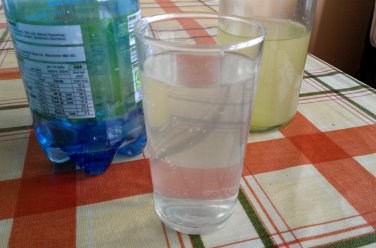 Dilute one part cordial to five or six parts cold still or sparkling water to taste.
Dilute one part cordial to five or six parts cold still or sparkling water to taste.
It can also be used undiluted as a dressing for fruit salad, or frozen in ice cube trays to make tasty ice for summer drinks.
Elderflowers, And Things That Are Not Elderflowers
Around the same time as Elder is flowering, there are a number of other things about that may look superficially similar, but should be avoided - mostly, just because they're not nice, but in some cases, because they could be poisonous.
These include:
- Guelder Rose (Viburnum opulus) - a tree of similar size to elder, but with smaller, rounder flower heads, and roundish leaves that have an orange tinge.
- Rowan or Mountain Ash (Sorbus spp) - this actually flowers a bit earlier than elder - the smell of the flowers is quite unpleasant - reminiscent of decayed food or urine.
- Cow Parsley - or other plants of the carrot family - these are herbaceous plants so shouldn't be easy to mistake for Elder, except that they are sometimes found growing right up through the middle of an Elder bush - however, a cursory examination of the flowers and stems is all that's needed to tell the difference.
